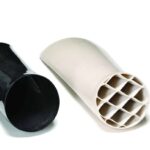Ethanol has five times higher volumetric energy density (6.7 kWh/L) than hydrogen (1.3 kWh/L) and can be used safely in fuel cells for power generation. In Brazil, in particular, there is great interest in improving the efficiency of fuel cells for ethanol as that country distributes low-cost ethanol produced in a renewable way from sugar cane. Theoretically, the efficiency of an ethanol fuel cell should be 96 percent, but in practice at the highest power density it is only 30 percent, due to a variety of reasons.
Nafion with nanoparticles
A team led by Dr. Bruno Matos from the Brazilian research institute IPEN (Nuclear and Energy Research Institute) is therefore investigating novel composite membranes for direct ethanol fuel cells. A promising solution is tailoring new polymer-based composite electrolyte materials to replace the state-of-the-art polymer electrolyte such as Nafion, a sulfonated tetrafluoroethylene based fluoropolymer-copolymer. Matos and his team use a melt extrusion process to produce composite membranes based on Nafion with additional titanate nanoparticles, which have been functionalized with sulfonic acid groups.
Infrared experiments at BESSY II
Matos’ team has now thoroughly analysed four different compositions of Nafion composite membranes at the infrared beamline IRIS at BESSY II, a third-generation synchrotron radiation source that produces extremely bright X-ray light located at the Helmholtz Zentrum Berlin (HZB). Small-angle X-ray scattering measurements confirmed that the titanium particles were synergistically interacting with the ionomer matrix of Nafion.
Proton conductivity increased
Using infrared spectroscopy, they observed that chemical bridges were formed between the sulfonic acid groups of the functionalized nanoparticles. In addition, by following the proton motion along the ionic clusters, they found increased proton conductivity in the composite membrane, even at high concentrations of nanoparticles. “This was a real surprise that we didn’t expect,” said Dr. Ljiljana Puskar, HZB-scientist at the IRIS-Beamline. The reduction of the conductivity with the increment of the nanoparticles is one of the main hurdles delaying the development of high-performance composite materials. The higher proton conductivity could allow better charge carrier mobility and thus increase the efficiency of the direct ethanol fuel cell.
Advantage of melt extrusion
“This composite membrane can be produced by melt extrusion, which would allow their production on industrial scale,” Matos pointed out.
More information: IPEN (Brazil); Helmholtz Zentrum Berlin (HZB)
Featured image: The material consists of Nafion with embedded nanoparticles. Credit: B.Matos/IPEN











